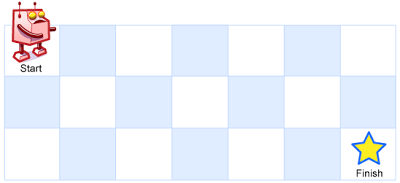Given a m x n grid filled with non-negative numbers, find a path from top left to bottom right which minimizes the sum of all numbers along its path.
Note: You can only move either down or right at any point in time.
Example:
1 | Input: |
Given a m x n grid filled with non-negative numbers, find a path from top left to bottom right which minimizes the sum of all numbers along its path.
Note: You can only move either down or right at any point in time.
Example:
1 | Input: |
A robot is located at the top-left corner of a m x n grid (marked ‘Start’ in the diagram below).
The robot can only move either down or right at any point in time. The robot is trying to reach the bottom-right corner of the grid (marked ‘Finish’ in the diagram below).
Now consider if some obstacles are added to the grids. How many unique paths would there be?

An obstacle and empty space is marked as 1 and 0 respectively in the grid.
Note: m and n will be at most 100.
Example 1:
1 | Input: |
A robot is located at the top-left corner of a m x n grid (marked ‘Start’ in the diagram below).
The robot can only move either down or right at any point in time. The robot is trying to reach the bottom-right corner of the grid (marked ‘Finish’ in the diagram below).
How many possible unique paths are there?

Above is a 7 x 3 grid. How many possible unique paths are there?
Example 1:
1 | Input: m = 3, n = 2 |
Example 2:
1 | Input: m = 7, n = 3 |
Constraints:
1 <= m, n <= 1002 * 10 ^ 9.Given a positive integer n, generate a square matrix filled with elements from 1 to n2 in spiral order.
Example:
1 | Input: 3 |
Given a matrix of m x n elements (m rows, n columns), return all elements of the matrix in spiral order.
Example 1:
1 | Input: |
Example 2:
1 | Input: |
Given a set of non-overlapping intervals, insert a new interval into the intervals (merge if necessary).
You may assume that the intervals were initially sorted according to their start times.
Example 1:
1 | Input: intervals = [[1,3],[6,9]], newInterval = [2,5] |
Example 2:
1 | Input: intervals = [[1,2],[3,5],[6,7],[8,10],[12,16]], newInterval = [4,8] |
NOTE: input types have been changed on April 15, 2019. Please reset to default code definition to get new method signature.
Given a collection of intervals, merge all overlapping intervals.
Example 1:
1 | Input: [[1,3],[2,6],[8,10],[15,18]] |
Example 2:
1 | Input: [[1,4],[4,5]] |
NOTE: input types have been changed on April 15, 2019. Please reset to default code definition to get new method signature.
Given an array of non-negative integers, you are initially positioned at the first index of the array.
Each element in the array represents your maximum jump length at that position.
Determine if you are able to reach the last index.
Example 1:
1 | Input: nums = [2,3,1,1,4] |
Example 2:
1 | Input: nums = [3,2,1,0,4] |
Constraints:
1 <= nums.length <= 3 * 10^40 <= nums[i][j] <= 10^5You are given an n x n 2D matrix representing an image.
Rotate the image by 90 degrees (clockwise).
Note:
You have to rotate the image in-place, which means you have to modify the input 2D matrix directly. DO NOT allocate another 2D matrix and do the rotation.
Example 1:
1 | Given input matrix = |
Example 2:
1 | Given input matrix = |
Given an array nums of n integers and an integer target, are there elements a, b, c, and d in nums such that a + b + c + d = target? Find all unique quadruplets in the array which gives the sum of target.
Note:
The solution set must not contain duplicate quadruplets.
Example:
1 | Given array nums = [1, 0, -1, 0, -2, 2], and target = 0. |